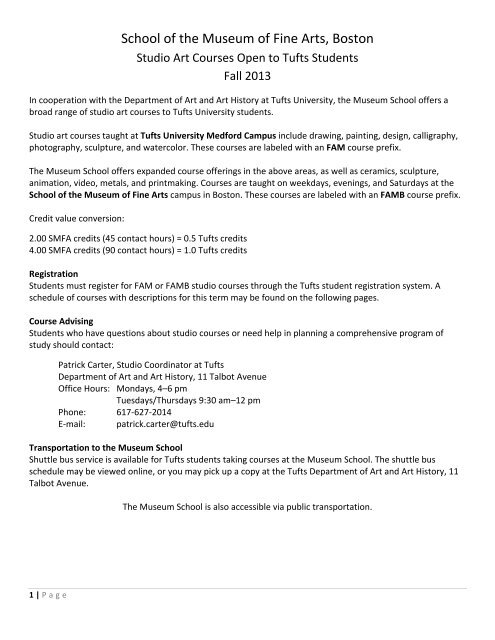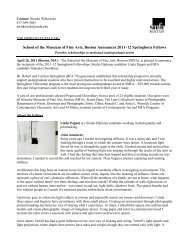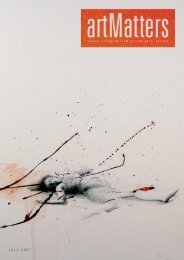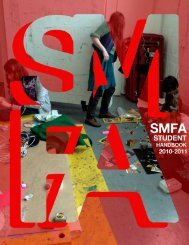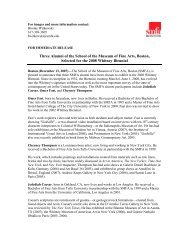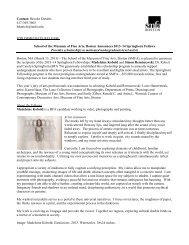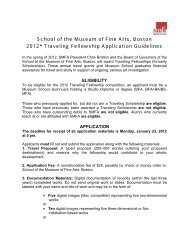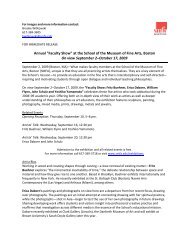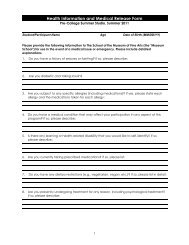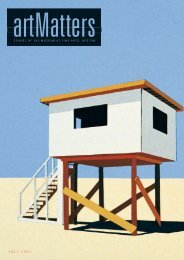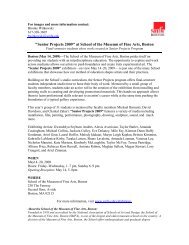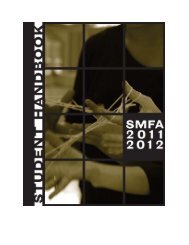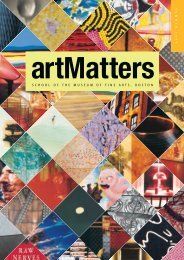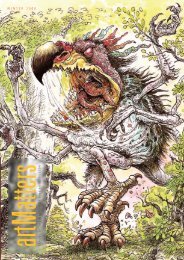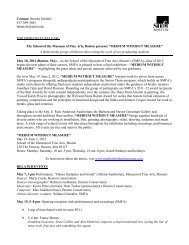Studio Art Courses at Tufts - School of the Museum of Fine Arts
Studio Art Courses at Tufts - School of the Museum of Fine Arts
Studio Art Courses at Tufts - School of the Museum of Fine Arts
Create successful ePaper yourself
Turn your PDF publications into a flip-book with our unique Google optimized e-Paper software.
<strong>School</strong> <strong>of</strong> <strong>the</strong> <strong>Museum</strong> <strong>of</strong> <strong>Fine</strong> <strong>Art</strong>s, Boston<br />
<strong>Studio</strong> <strong>Art</strong> <strong>Courses</strong> Open to <strong>Tufts</strong> Students<br />
Fall 2013<br />
In cooper<strong>at</strong>ion with <strong>the</strong> Department <strong>of</strong> <strong>Art</strong> and <strong>Art</strong> History <strong>at</strong> <strong>Tufts</strong> University, <strong>the</strong> <strong>Museum</strong> <strong>School</strong> <strong>of</strong>fers a<br />
broad range <strong>of</strong> studio art courses to <strong>Tufts</strong> University students.<br />
<strong>Studio</strong> art courses taught <strong>at</strong> <strong>Tufts</strong> University Medford Campus include drawing, painting, design, calligraphy,<br />
photography, sculpture, and w<strong>at</strong>ercolor. These courses are labeled with an FAM course prefix.<br />
The <strong>Museum</strong> <strong>School</strong> <strong>of</strong>fers expanded course <strong>of</strong>ferings in <strong>the</strong> above areas, as well as ceramics, sculpture,<br />
anim<strong>at</strong>ion, video, metals, and printmaking. <strong>Courses</strong> are taught on weekdays, evenings, and S<strong>at</strong>urdays <strong>at</strong> <strong>the</strong><br />
<strong>School</strong> <strong>of</strong> <strong>the</strong> <strong>Museum</strong> <strong>of</strong> <strong>Fine</strong> <strong>Art</strong>s campus in Boston. These courses are labeled with an FAMB course prefix.<br />
Credit value conversion:<br />
2.00 SMFA credits (45 contact hours) = 0.5 <strong>Tufts</strong> credits<br />
4.00 SMFA credits (90 contact hours) = 1.0 <strong>Tufts</strong> credits<br />
Registr<strong>at</strong>ion<br />
Students must register for FAM or FAMB studio courses through <strong>the</strong> <strong>Tufts</strong> student registr<strong>at</strong>ion system. A<br />
schedule <strong>of</strong> courses with descriptions for this term may be found on <strong>the</strong> following pages.<br />
Course Advising<br />
Students who have questions about studio courses or need help in planning a comprehensive program <strong>of</strong><br />
study should contact:<br />
P<strong>at</strong>rick Carter, <strong>Studio</strong> Coordin<strong>at</strong>or <strong>at</strong> <strong>Tufts</strong><br />
Department <strong>of</strong> <strong>Art</strong> and <strong>Art</strong> History, 11 Talbot Avenue<br />
Office Hours: Mondays, 4–6 pm<br />
Tuesdays/Thursdays 9:30 am–12 pm<br />
Phone: 617‐627‐2014<br />
E‐mail: p<strong>at</strong>rick.carter@tufts.edu<br />
Transport<strong>at</strong>ion to <strong>the</strong> <strong>Museum</strong> <strong>School</strong><br />
Shuttle bus service is available for <strong>Tufts</strong> students taking courses <strong>at</strong> <strong>the</strong> <strong>Museum</strong> <strong>School</strong>. The shuttle bus<br />
schedule may be viewed online, or you may pick up a copy <strong>at</strong> <strong>the</strong> <strong>Tufts</strong> Department <strong>of</strong> <strong>Art</strong> and <strong>Art</strong> History, 11<br />
Talbot Avenue.<br />
The <strong>Museum</strong> <strong>School</strong> is also accessible via public transport<strong>at</strong>ion.<br />
1 | P age
FAM – <strong>Studio</strong> <strong>Art</strong> <strong>Courses</strong> <strong>at</strong> <strong>Tufts</strong><br />
FAM 0003 B <strong>Art</strong> as Process 0.50 Credit<br />
K<strong>at</strong>a Hull<br />
F 9:30 am ‐ 12:30 pm LANE HALL STUDIOS<br />
This course is for individuals who want to transform and develop <strong>the</strong>ir artistic practice and visual awareness. <strong>Art</strong> as<br />
Process is an intensive studio class th<strong>at</strong> focuses on experiment<strong>at</strong>ion and <strong>the</strong> cre<strong>at</strong>ive process r<strong>at</strong>her than a pre‐imagined<br />
or calcul<strong>at</strong>ed end product. Each week a different project will be introduced, worked on and completed. We will explore<br />
painting, drawing, sculpture, install<strong>at</strong>ion and o<strong>the</strong>r disciplines and media with an eye toward investig<strong>at</strong>ing unique ways<br />
<strong>of</strong> making art. Abstraction, Realism and Conceptual approaches will be addressed and explored through a variety <strong>of</strong><br />
hands‐on projects. Individual and collabor<strong>at</strong>ive exercises will challenge students to broaden <strong>the</strong>ir awareness <strong>of</strong> personal<br />
and assimil<strong>at</strong>ed beliefs, conceptual ideas and autobiographical content through <strong>the</strong> use <strong>of</strong> metaphor, symbol and<br />
unconventional media. Class discussions, readings, present<strong>at</strong>ions and field trips will supplement studio practice and look<br />
<strong>at</strong> art making in context <strong>of</strong> historical, cultural and contemporary issues. The interactive, particip<strong>at</strong>ory n<strong>at</strong>ure <strong>of</strong> <strong>Art</strong> as<br />
Process enables students coming from diverse areas <strong>of</strong> study to expand and enrich <strong>the</strong>ir perspectives <strong>of</strong> <strong>the</strong> broader<br />
community. Open to all, from absolute beginners to advanced artists, <strong>Art</strong> as Process is particularly useful for those<br />
interested in exploring and developing <strong>the</strong>ir own cre<strong>at</strong>ive abilities, assembling a portfolio or exploring <strong>the</strong> idea <strong>of</strong> a<br />
pr<strong>of</strong>essional art career.<br />
FAM 0005 A Calligraphy 1.00 Credit<br />
Polly Broman‐Wright<br />
TR 7:00 pm ‐ 10:00 pm LANE HALL STUDIOS<br />
This course introduces both a way <strong>of</strong> seeing line, form and space and <strong>the</strong> basics <strong>of</strong> design through pen‐drawn letters.<br />
Concentr<strong>at</strong>ing on <strong>the</strong> basic Italic letterforms and touching on <strong>the</strong> Square Roman capitals, emphasis will be on developing<br />
rhythm and freedom <strong>of</strong> line, as well as layout and design. Several projects exploring <strong>the</strong> expressive possibilities <strong>of</strong><br />
contemporary calligraphy will be completed during <strong>the</strong> semester.<br />
FAM 0006 A Calligraphy Intermedi<strong>at</strong>e to Advanced 1.00 Credit<br />
Polly Broman‐Wright<br />
TR 7:00 pm ‐ 10:00 pm LANE HALL STUDIOS<br />
In this course, which is a continu<strong>at</strong>ion <strong>of</strong> <strong>the</strong> first semester <strong>of</strong> Calligraphy, <strong>the</strong> Roman Capitals will be studied more fully<br />
through projects emphasizing spacing and proportions. This will be followed by <strong>the</strong> cre<strong>at</strong>ion <strong>of</strong> a personal capital letter<br />
design through rapid writing and <strong>the</strong> possible use <strong>of</strong> non‐traditional writing tools. O<strong>the</strong>r scripts will also be studied<br />
based on historic examples and utilized in cre<strong>at</strong>ive projects using color and decor<strong>at</strong>ion. As a culmin<strong>at</strong>ion <strong>of</strong> <strong>the</strong><br />
semester's work, students will design, write and bind a manuscript book. Continued courses may be taken for credit for<br />
an unlimited number <strong>of</strong> times.<br />
FAM 0020 01 Design Found<strong>at</strong>ion 1.00 Credit<br />
Joanne Breiner<br />
MW 1:30 pm ‐ 4:30 pm LANE HALL STUDIOS<br />
The design process involves <strong>the</strong> development <strong>of</strong> skills as a conceptual and visual problem solver. Using <strong>the</strong> fundamental<br />
principles <strong>of</strong> design to give form to ideas, you will explore <strong>the</strong> use <strong>of</strong> line, texture, grid, color, composition, typography<br />
and o<strong>the</strong>r elements to solve graphic problems and understand <strong>the</strong> language <strong>of</strong> design. The course will use both <strong>the</strong><br />
studio and computer lab to study how to make design choices and develop your cre<strong>at</strong>ive problem solving abilities and<br />
technical skills. This course addresses design terminology such as tension, emphasis, scale, symmetry, balance and o<strong>the</strong>r<br />
elements <strong>of</strong> image and form. A basic understanding <strong>of</strong> design history, concepts and <strong>the</strong> source <strong>of</strong> cre<strong>at</strong>ivity is a resource<br />
2 | P age
for understanding how design affects our daily lives. This is an excellent course <strong>of</strong> anyone working in, or just starting<br />
out, in <strong>the</strong> visual arts.<br />
FAM 0021 01 Design: Intermedi<strong>at</strong>e to Advanced 1.00 Credit<br />
Joanne Breiner<br />
MW 1:30 pm ‐ 4:30 pm LANE HALL STUDIOS<br />
This course is a continu<strong>at</strong>ion <strong>of</strong> Design: Found<strong>at</strong>ion and is intended for <strong>the</strong> serious student who wants to develop 2‐D<br />
and 3‐D design skills. Elements <strong>of</strong> design encountered in Design: Found<strong>at</strong>ion will be re‐examined to see how <strong>the</strong>y can be<br />
used in new situ<strong>at</strong>ions, including commercial applic<strong>at</strong>ions. The use <strong>of</strong> a variety <strong>of</strong> media and particip<strong>at</strong>ion in critiques is<br />
encouraged. Continued courses may be taken for credit an unlimited number <strong>of</strong> times.<br />
FAM 0022 A Design: Architectural 1.00 Credit<br />
Jenny French<br />
MW 7:00 pm ‐ 10:00 pm LANE HALL STUDIOS<br />
This course <strong>of</strong>fers an introduction to architectural design through an intensive studio experience. In <strong>the</strong> design studio,<br />
work is advanced primarily by independent student explor<strong>at</strong>ion and guided by critical discussions with <strong>the</strong> instructor,<br />
guest critics, and <strong>the</strong> studio <strong>at</strong> large. A number <strong>of</strong> lecture present<strong>at</strong>ions and demonstr<strong>at</strong>ions introduce key topics, but<br />
much <strong>of</strong> <strong>the</strong> learning and growth relies on active discussions <strong>of</strong> <strong>the</strong> collective body <strong>of</strong> studio work. You will learn how to<br />
abstractly analyze, represent, and cre<strong>at</strong>e space through a series <strong>of</strong> design projects th<strong>at</strong> increase in complexity and<br />
dur<strong>at</strong>ion throughout <strong>the</strong> semester. Your work will incorpor<strong>at</strong>e drawing and modeling techniques, concept development,<br />
sp<strong>at</strong>ial thinking, multi‐scalar awareness, program analysis, context analysis, and many o<strong>the</strong>r layers <strong>of</strong> <strong>the</strong> architectural<br />
design process. The studio takes advantage <strong>of</strong> Boston as a primary resource by visiting relevant local works <strong>of</strong><br />
architecture, <strong>at</strong>tending local lectures in architecture, and accessing local architecture libraries, all <strong>of</strong> which open <strong>the</strong><br />
studio’s boundaries to <strong>the</strong> broader contemporary design world. There are no explicit prerequisites for <strong>the</strong> course,<br />
though students are strongly encouraged to take <strong>at</strong> least one college level architectural history or art history course, as<br />
well as a studio art course. This is a high‐demand course: applic<strong>at</strong>ions are available in <strong>the</strong> Department <strong>of</strong> <strong>Art</strong> and <strong>Art</strong><br />
History, 11 Talbot Ave.<br />
FAM 0023 A Design: Advanced Architectural 1.00 Credit<br />
Jenny French<br />
MW 7:00 pm ‐ 10:00 pm LANE HALL STUDIOS<br />
This course builds upon <strong>the</strong> found<strong>at</strong>ional knowledge th<strong>at</strong> is covered in <strong>the</strong> introductory level and aims to achieve a<br />
higher degree <strong>of</strong> architectural design sophistic<strong>at</strong>ion through a series <strong>of</strong> projects. These design challenges increase in<br />
complexity and dur<strong>at</strong>ion over <strong>the</strong> course <strong>of</strong> <strong>the</strong> semester. You are expected to have advanced skills in drawing and<br />
model making, which enable you to devote your time to developing and critiquing your own design process. You will<br />
delve deeper into issues <strong>of</strong> context, form, and space, and you will be expected to draw upon previous design work from<br />
rel<strong>at</strong>ed courses such as architectural history, architectural engineering, urban planning, sculpture, drawing, and o<strong>the</strong>rs.<br />
The studio takes advantage <strong>of</strong> Boston as a primary resource by visiting relevant local works <strong>of</strong> architecture, <strong>at</strong>tending<br />
local lectures in architecture, and accessing local architecture libraries, all <strong>of</strong> which open <strong>the</strong> studio’s boundaries to <strong>the</strong><br />
broader contemporary design world. This course is intended for students who have already taken FAM 22 or its<br />
equivalent <strong>at</strong> ano<strong>the</strong>r institution. This is a high‐demand course: applic<strong>at</strong>ions are available in <strong>the</strong> Department <strong>of</strong> <strong>Art</strong> and<br />
<strong>Art</strong> History, 11 Talbot Ave.<br />
FAM 0024 01 Introduction to Drawing 0.50 Credit<br />
Mela Lyman<br />
F 1:30 pm ‐ 4:30 pm LANE HALL STUDIOS<br />
3 | P age
Drawing is a basic skill through which visual ideas and feelings take form. This introductory course explores drawing as a<br />
means <strong>of</strong> learning to see. Through <strong>the</strong> basic visual elements th<strong>at</strong> define shape we will explore <strong>the</strong> tools th<strong>at</strong> give<br />
expression to artists’ feelings and ideas, represent<strong>at</strong>ions, p<strong>at</strong>terns and abstractions, sketches, plans and o<strong>the</strong>r uses, (e.g.<br />
earthworks, sculpture, design projects, etc.) Traditional methods <strong>of</strong> observ<strong>at</strong>ional drawing, including systems <strong>of</strong><br />
perspective, will be addressed through <strong>the</strong> use <strong>of</strong> live models, still life, design problems. A variety <strong>of</strong> media will be<br />
explored: charcoal, erasers, sumi ink, and paper. Current methods and approaches to drawing will be viewed and shared<br />
in <strong>the</strong> class work and digitally. Ongoing references to recent and historical drawing are part <strong>of</strong> our curriculum; from cave<br />
drawing to anim<strong>at</strong>ion. We will have field trips drawing outside and visiting museums. Attendance is essential for<br />
developing ideas and honing skills; group discussions and critiques an ongoing inspir<strong>at</strong>ion. This course is open to<br />
beginners and experienced artists.<br />
FAM 0026 A Drawing: Found<strong>at</strong>ion 1.00 Credit<br />
Ria Brodell<br />
TR 7:00 pm ‐ 10:00 pm LANE HALL STUDIOS<br />
FAM 0026 C Drawing: Found<strong>at</strong>ion 1.00 Credit<br />
Greg Menc<strong>of</strong>f<br />
MW 7:00 pm ‐ 10:00 pm LANE HALL STUDIOS<br />
FAM 0026 D Drawing: Found<strong>at</strong>ion 1.00 Credit<br />
Justin Life<br />
MW 1:30 pm ‐ 4:30 pm LANE HALL STUDIOS<br />
Drawing is an ancient and universal practice as well as an aspect <strong>of</strong> visual thinking. Working from direct and indirect<br />
observ<strong>at</strong>ions, students will develop <strong>the</strong> confidence to evalu<strong>at</strong>e shape, line quality, value, composition, and how <strong>the</strong><br />
critical choice <strong>of</strong> m<strong>at</strong>erials will impact an idea. Drawing Found<strong>at</strong>ions introduces drawing as a practice <strong>of</strong> observ<strong>at</strong>ion. We<br />
approach <strong>the</strong> illusion <strong>of</strong> space and form through formal analysis and subjective interpret<strong>at</strong>ion. Found<strong>at</strong>ions examines<br />
<strong>the</strong> multiple functions <strong>of</strong> drawing across time and culture as well as emphasizing <strong>the</strong> breadth <strong>of</strong> <strong>the</strong> drawing experience<br />
and its applic<strong>at</strong>ion across disciplines. The course provides a form<strong>at</strong> for a focused explor<strong>at</strong>ion <strong>of</strong> drawing practice as an<br />
instrument <strong>of</strong> communic<strong>at</strong>ion, a source <strong>of</strong> ideas and an opportunity to risk and move beyond one’s current abilities and<br />
notions.<br />
FAM 0027 B Drawing: Intermedi<strong>at</strong>e to Advanced 1.00 Credit<br />
P<strong>at</strong>rick Carter<br />
TR 1:30 pm ‐ 4:30 pm LANE HALL STUDIOS<br />
This course is a continu<strong>at</strong>ion <strong>of</strong> Drawing Found<strong>at</strong>ion or Introduction to Drawing; or for those with fundamental drawing<br />
skills and wish to continue working with drawing. The first objective is to build on <strong>the</strong> experiences one had with drawing,<br />
and determine personal directions and approaches within a variety <strong>of</strong> subjects. This course is tailored to <strong>the</strong> individual<br />
student’s sensibilities and n<strong>at</strong>ural inclin<strong>at</strong>ions. Students are encouraged to experiment with pencil, pen, charcoal, color<br />
and pastels, w<strong>at</strong>er based paints (gouache, w<strong>at</strong>ercolor, acrylics), mixed media; as well as various papers and surfaces. The<br />
purpose is to equip <strong>the</strong> student with a range <strong>of</strong> possible consider<strong>at</strong>ions in order to have choices to work in one medium;<br />
or experiment combining two or three. The objective is to produce a body <strong>of</strong> work with a personal vision based on<br />
perceptions <strong>of</strong> subjects such as <strong>the</strong> figure, <strong>the</strong> landscape, or objects as points <strong>of</strong> departure. This course includes visits to<br />
Boston area art museums to view art toge<strong>the</strong>r and search for visual inform<strong>at</strong>ion and inspir<strong>at</strong>ion.<br />
FAM 0035 01 Figure Drawing 0.50 Credit<br />
Mela Lyman<br />
W 9:30 am ‐ 12:30 pm LANE HALL STUDIOS<br />
Contemporary and traditional approaches to <strong>the</strong> figure will be <strong>the</strong> focus and inspir<strong>at</strong>ion for this course. Composition,<br />
light, gesture, line, contour and space will be addressed through <strong>the</strong> juxtaposition <strong>of</strong> models and objects. Proportion and<br />
4 | P age
traditional methods for observ<strong>at</strong>ional drawing, including perspective, will be addressed. A variety <strong>of</strong> m<strong>at</strong>erials will be<br />
explored providing opportunities for gre<strong>at</strong>er experiment<strong>at</strong>ion and expression; charcoal, sumi ink, graphite, erasers and<br />
o<strong>the</strong>r w<strong>at</strong>er based media. Explor<strong>at</strong>ion <strong>of</strong> o<strong>the</strong>r artists past and present will provide context for understanding art<br />
making, its history and inspir<strong>at</strong>ion. Ongoing class convers<strong>at</strong>ion and critiques will encourage <strong>the</strong> development <strong>of</strong> ideas<br />
and experiment<strong>at</strong>ion. This course is open to beginners and experienced artists.<br />
FAM 0039 A Graphic Design 1.00 Credit<br />
Marcy Pape<br />
MW 7:00 pm ‐ 10:00 pm<br />
This is a graphic design course in visual communic<strong>at</strong>ions. Students will learn basic computer skills using Adobe Illustr<strong>at</strong>or<br />
to solve assignments. Projects will be geared toward using graphics as a means <strong>of</strong> communic<strong>at</strong>ions. Students are<br />
encouraged to experiment with conceptual ideas, visual literacy, typography and <strong>the</strong> principles <strong>of</strong> design. Assignments<br />
will progress in complexity in order to help <strong>the</strong> student develop a personal style. This course is designed to<br />
accommod<strong>at</strong>e both beginner and more advanced students through individual and class critiques. The course culmin<strong>at</strong>es<br />
with student portfolios.<br />
FAM 0040 A Graphic Design II 1.00 Credit<br />
Marcy Pape<br />
MW 7:00 pm ‐ 10:00 pm<br />
This is an advanced course in advertising design. Students will work individually on graphic design problems to fur<strong>the</strong>r<br />
develop <strong>the</strong>ir awareness <strong>of</strong> how design enhances communic<strong>at</strong>ion. Assignments reflect specific client requirements and<br />
encourage students to build on <strong>the</strong>ir computer competency. Each assignment develops analysis skills along with<br />
advanced problem solving. The course culmin<strong>at</strong>es with a portfolio. Continued graphic design courses may be taken for<br />
credit an unlimited number <strong>of</strong> times.<br />
FAM 0052 01 Introduction to Painting 0.50 Credit<br />
Susan Belton<br />
F 9:30 am ‐ 12:30 pm LANE HALL STUDIOS<br />
This course exposes students to <strong>the</strong> issues and techniques <strong>of</strong> contemporary painting. In weekly exercises using oil or<br />
acrylic paints, students will explore techniques rel<strong>at</strong>ed to current concepts about art making and painting such as color<br />
<strong>the</strong>ory, composition and design, and <strong>the</strong> roles <strong>of</strong> intention and meaning in art making practices. Students will visit a<br />
museum to find historical connections to issues discussed in class. They will visit galleries, altern<strong>at</strong>ive spaces and<br />
practicing artist’s studios to experiment with ideas gener<strong>at</strong>ed <strong>the</strong>re in <strong>the</strong>ir own class work. In a final project <strong>the</strong>y will<br />
research an iconic painting and experiment with ways current painters expand traditional vocabulary by cre<strong>at</strong>ing <strong>the</strong>ir<br />
own contemporary response to it.<br />
FAM 0053 01 Intro to Painting Continued 0.50 Credit<br />
Lizi Brown<br />
F 1:30 pm ‐ 4:30 pm LANE HALL STUDIOS<br />
This course is a continu<strong>at</strong>ion <strong>of</strong> Introduction to Painting (FAM 0052). Students work more independently and explore<br />
advanced painting techniques and issues. We investig<strong>at</strong>e work by contemporary artists and explore wh<strong>at</strong> it means to be<br />
a painter in <strong>the</strong> 21st century, influenced by global art history, as well as photography and digital media. Personal<br />
commitment, vision, and curiosity are <strong>the</strong> driving forces behind <strong>the</strong> work produced in <strong>the</strong> class. Emphasis is on<br />
developing one’s own tastes and sensibilities as an artist. Individual and group critiques are conducted throughout <strong>the</strong><br />
semester. A variety <strong>of</strong> levels are welcome. All are challenged with <strong>at</strong>taining a higher degree <strong>of</strong> pr<strong>of</strong>iciency and moving<br />
closer to <strong>the</strong>ir artistic goals.<br />
FAM 0054 01 Found<strong>at</strong>ion Painting 1.00 Credit<br />
5 | Page
Molly Segal<br />
TR 1:30 pm ‐ 4:30 pm LANE HALL STUDIOS<br />
FAM 0054 02 Found<strong>at</strong>ion Painting 1.00 Credit<br />
Marilyn Levin<br />
MW 7:00 pm ‐ 10:00 pm LANE HALL STUDIOS<br />
This course is an introduction to <strong>the</strong> m<strong>at</strong>erials and methods <strong>of</strong> painting. The framework <strong>of</strong> <strong>the</strong> course emphasizes <strong>the</strong><br />
importance <strong>of</strong> individual responses and ideas; <strong>the</strong>refore no prior experience is required. Paint is used in exploring a wide<br />
range <strong>of</strong> subject m<strong>at</strong>ter, from ordinary, everyday objects to <strong>the</strong> human figure and face. Work in progress is discussed<br />
consistently with each individual and with <strong>the</strong> group as a whole. The purpose <strong>of</strong> <strong>the</strong> course is to develop both a broad<br />
understanding <strong>of</strong> color, shape, structure and space, and <strong>the</strong> confidence to recognize and value <strong>the</strong> extraordinary process<br />
<strong>of</strong> making art.<br />
FAM 0055 01 Painting: Intermedi<strong>at</strong>e‐Advanced 1.00 Credit<br />
Molly Segal<br />
TR 1:30 pm ‐ 4:30 pm LANE HALL STUDIOS<br />
FAM 0055 02 Painting: Intermedi<strong>at</strong>e‐Advanced 1.00 Credit<br />
Marilyn Levin<br />
MW 7:00 pm ‐ 10:00 pm LANE HALL STUDIOS<br />
This course is an extension <strong>of</strong> Painting: Found<strong>at</strong>ion (FAM 0054) with a much gre<strong>at</strong>er emphasis on independent and<br />
personal directions. The explor<strong>at</strong>ion <strong>of</strong> m<strong>at</strong>erials will include <strong>the</strong> use <strong>of</strong> oil paint and a more varied use <strong>of</strong> scale and<br />
surface. The assignment sets are more challenging and require more imagin<strong>at</strong>ive solutions developed through<br />
discussion and evalu<strong>at</strong>ion <strong>of</strong> work in progress. Note: continued courses may be taken for credit an unlimited number <strong>of</strong><br />
times.<br />
FAM 0063 01 Perspective Drawing 0.50 Credit<br />
Mela Lyman<br />
T 9:30 am – 12:30 pm LANE HALL STUDIOS<br />
This comprehensive course in basic perspective drawing is open to all levels and is devoted to drawing from observ<strong>at</strong>ion.<br />
Still lives in <strong>the</strong> studio and some field trips to outside loc<strong>at</strong>ions will provide our subject m<strong>at</strong>ter and sources <strong>of</strong> inspir<strong>at</strong>ion.<br />
Through various methods for cre<strong>at</strong>ing <strong>the</strong> illusion <strong>of</strong> realism we will utilize <strong>the</strong> elements <strong>of</strong> line, shape, texture, value,<br />
composition and <strong>the</strong> techniques <strong>of</strong> western perspective design to convincingly portray 3D volume and space on a 2D<br />
surface. Towards <strong>the</strong> end <strong>of</strong> <strong>the</strong> course <strong>the</strong>se tools will be used to design and cre<strong>at</strong>e your own ideas and structures;<br />
drawings, houses, monuments, memorials, autos, objects and sculptures, etc. <strong>of</strong> your choosing. Our explor<strong>at</strong>ion and<br />
work will provide insight into wh<strong>at</strong> has given this discipline its time honored visual appeal and help us to cre<strong>at</strong>e new and<br />
unique perspective drawings and designs. M<strong>at</strong>erials include charcoal, graphite, erasers, rulers, sumi ink and paper.<br />
FAM 0064 A Photo Found<strong>at</strong>ion 1.00 Credit<br />
Roswell Angier<br />
MW 1:30 pm ‐ 4:30 pm<br />
FAM 0064 B Photo Found<strong>at</strong>ion 1.00 Credit<br />
Dore Gardner<br />
TR 1:30 pm ‐ 4:30 pm<br />
FAM 0064 C Photo Found<strong>at</strong>ion 1.00 Credit<br />
Michael Mandel<br />
TR 7:00 pm ‐ 10:00 pm<br />
These found<strong>at</strong>ion courses will cover fundamental aspects <strong>of</strong> photography as a means <strong>of</strong> personal expression: craft,<br />
seeing/perception, design, critiquing, history and hard work. The acquisition <strong>of</strong> basic skills in <strong>the</strong> craft <strong>of</strong> photography<br />
6 | P age
necessary to make technically good black and white prints will be emphasized along with <strong>the</strong> development <strong>of</strong> a<br />
photographic aes<strong>the</strong>tic. Critiques will be held to assist students in judging <strong>the</strong>ir work. The course will also give basic<br />
historical inform<strong>at</strong>ion to provide a context in which <strong>the</strong> students will be working. Students will be introduced to<br />
electronic imaging if time permits. Students must have a manually adjustable (non‐autom<strong>at</strong>ic) 35mm camera with a<br />
50mm lens and provide film and printing paper. The school will provide chemicals and darkroom facilities. Approxim<strong>at</strong>e<br />
cost <strong>of</strong> supplies will be $150. Three to six hours per week <strong>of</strong> lab time outside <strong>of</strong> class will be required.<br />
FAM 0065 A Photography & Computer 1.00 Credit<br />
Thomas MacIntyre<br />
TR 4:00 pm ‐ 6:45 pm<br />
This course is an introduction to <strong>the</strong> techniques <strong>of</strong> electronic imaging as <strong>the</strong>y rel<strong>at</strong>e to <strong>the</strong> practice <strong>of</strong> photography.<br />
Students will learn <strong>the</strong> basics <strong>of</strong> digitizing, image editing, and manipul<strong>at</strong>ion with Adobe Photoshop. In addition to regular<br />
assignments and critiques, <strong>the</strong>re will be frequent class discussions <strong>of</strong> critical and historical issues raised by <strong>the</strong><br />
introduction <strong>of</strong> <strong>the</strong> computer into <strong>the</strong> practice <strong>of</strong> photography. Some familiarity with computers is desirable, but not<br />
absolutely necessary.<br />
FAM 0067 01 Photo: Intermedi<strong>at</strong>e‐Advanced 1.00 Credit<br />
Roswell Angier<br />
MW 7:00 pm ‐ 10:00 pm<br />
This course presumes a basic working knowledge <strong>of</strong> analog photographic m<strong>at</strong>erials and processes: how to expose and<br />
develop film and how to print <strong>the</strong> neg<strong>at</strong>ives. Students will be introduced to medium and large form<strong>at</strong> film photography<br />
and basic lighting techniques. In addition, <strong>the</strong> technical aspect <strong>of</strong> <strong>the</strong> course emphasizes finer control <strong>of</strong> analog<br />
equipment and m<strong>at</strong>erials, as well as basic components <strong>of</strong> digital photography. Students will spend most <strong>of</strong> <strong>the</strong>ir time<br />
working on an extended project, centered on a special topic, which changes every semester. Development <strong>of</strong> visual<br />
ideas will be emphasized. Individual and group critiques will be arranged in order to broaden students’ personal<br />
approaches, and encourage a fuller understanding <strong>of</strong> <strong>the</strong> historical and critical context <strong>of</strong> photographic practices. Class<br />
<strong>at</strong>tendance is mand<strong>at</strong>ory and group particip<strong>at</strong>ion is highly encouraged.<br />
FAM 0077 A Sculpture: Found<strong>at</strong>ion 1.00 Credit<br />
Brenda Star<br />
MW 1:30 pm ‐ 4:30 pm LANE HALL STUDIOS<br />
This introductory course is designed for students interested in working in clay as well as constructing in o<strong>the</strong>r<br />
m<strong>at</strong>erials. We begin <strong>the</strong> course working with clay and explore <strong>the</strong> traditional methods <strong>of</strong> modeling to see how form<br />
texture and light affect your perception. Through a process <strong>of</strong> hands‐on experience, thoughtful exchange <strong>of</strong> ideas<br />
and experiment<strong>at</strong>ion we will cre<strong>at</strong>e a series <strong>of</strong> sculptures representing your discoveries about a chosen object.<br />
Traditional m<strong>at</strong>erials and methods will be kept simple so th<strong>at</strong> concentr<strong>at</strong>ion can be devoted to <strong>the</strong> product. After<br />
our explor<strong>at</strong>ion with clay we will use various media: cardboard, wood, plaster, glued constructions, wire, found objects,<br />
and recycled m<strong>at</strong>erial. Students have also used m<strong>at</strong>erials as diverse as jell‐o, balloons, newspaper, moss, w<strong>at</strong>er, and dirt<br />
to cre<strong>at</strong>e sculptures. This class is about developing your personal vision, exploring your imagin<strong>at</strong>ion in three dimensions,<br />
and responding to your intuition. You will also see <strong>the</strong> importance <strong>of</strong> honing your choice <strong>of</strong> m<strong>at</strong>erials to<br />
most successfully express your ideas. Sculpture, once defined as objects in space, now exists in an expanding field <strong>of</strong><br />
invention and intervention, including technology and performance. Films, videos, websites, and readings on a variety <strong>of</strong><br />
topics from art and performance to neuroscience will augment <strong>the</strong> class experience.<br />
FAM 0093 A W<strong>at</strong>ercolor 1.00 Credit<br />
K<strong>at</strong>e Finnegan<br />
TR 1:30 pm ‐ 4:30 pm LANE HALL STUDIOS<br />
This course is an introduction to w<strong>at</strong>ercolor painting for beginners. The basic techniques and <strong>the</strong> characteristics inn<strong>at</strong>e<br />
7 | P age
to <strong>the</strong> w<strong>at</strong>ercolor medium will be explored. Frequent exercises will develop <strong>the</strong> individual's understanding <strong>of</strong> <strong>the</strong><br />
medium in technical, expressive, and historical terms. Gre<strong>at</strong> w<strong>at</strong>ercolorists will be studied. There will be a trip to see<br />
contemporary w<strong>at</strong>ercolors in a Boston gallery and paintings from <strong>the</strong> <strong>Museum</strong> <strong>of</strong> <strong>Fine</strong> <strong>Art</strong>s' w<strong>at</strong>ercolor collection. Basic<br />
skills will include w<strong>at</strong>ercolor techniques, light, figure‐ground rel<strong>at</strong>ionships, and color.<br />
FAM 0094 A W<strong>at</strong>ercolor: Intermedi<strong>at</strong>e ‐Advanced 1.00 Credit<br />
K<strong>at</strong>e Finnegan<br />
TR 1:30 pm ‐ 4:30 pm LANE HALL STUDIOS<br />
In this course students will develop <strong>the</strong> expressive and technical skills acquired <strong>the</strong> first semester and expand <strong>the</strong>ir<br />
understanding <strong>of</strong> <strong>the</strong> elements th<strong>at</strong> work toge<strong>the</strong>r to make a painting. Note: Continued course may be taken for credit<br />
an unlimited number <strong>of</strong> times.<br />
FAM 0193 01 Special Topics: Printmaking without a Press 0.50 Credit<br />
Garett Yahn<br />
R 7:00 pm ‐ 10:00 pm LANE HALL STUDIOS<br />
In this course students will be introduced to a variety <strong>of</strong> printmaking techniques th<strong>at</strong> can be completed without <strong>the</strong> use<br />
<strong>of</strong> a press. Included are plexiglass and single line monotype techniques, wood and linoleum block printing, and several<br />
transfer techniques. Students will also learn basic registr<strong>at</strong>ion procedures useful for printing multiples or works in a<br />
series. The class will experiment with a variety <strong>of</strong> imagery, as well as inks and paper. Examples <strong>of</strong> contemporary artists<br />
who use printmaking in <strong>the</strong>ir practices will be shown and discussed. Students will have <strong>the</strong> opportunity to particip<strong>at</strong>e in<br />
a portfolio exchange with classm<strong>at</strong>es. Open to all levels <strong>of</strong> artmaking experience.<br />
FAM 0193 02 Special Topics: Bookmaking & <strong>Art</strong>ists’ Books 0.50 Credit<br />
Garett Yahn<br />
W 9:30 am ‐ 12:30 pm LANE HALL STUDIOS<br />
This course covers <strong>the</strong> production <strong>of</strong> books and public<strong>at</strong>ions in an art context. Students will learn basic bookmaking<br />
skills including how to cre<strong>at</strong>e a variety <strong>of</strong> forms, structures, and bindings. The class will explore <strong>the</strong> rel<strong>at</strong>ionship<br />
between image, text, and <strong>the</strong> sculptural book form. Students will also examine <strong>the</strong> historical and contemporary field <strong>of</strong><br />
artists books and public<strong>at</strong>ions from <strong>the</strong> artist's monograph to <strong>the</strong> Xerox Book. Class time will be a mix <strong>of</strong> technical<br />
demonstr<strong>at</strong>ions, slides, lectures, and studio time. Open to all skill levels.<br />
FAM 0193 04 Special Topics: Contemporary Portrait 0.50 Credit<br />
Lizi Brown<br />
W 9:30 am ‐ 12:30 pm LANE HALL STUDIOS<br />
This intensive portrait course is designed to help students syn<strong>the</strong>size cre<strong>at</strong>ive and analytical skills, combining right and<br />
left brain activities for more productive studio practice. We examine contemporary portrait artists as well as solutions to<br />
technical painting questions. Working with models for more than half <strong>of</strong> our studio time, students learn to identify, mix,<br />
and apply color in <strong>the</strong> complex landscape <strong>of</strong> <strong>the</strong> human face. We explore observ<strong>at</strong>ional and emotional uses <strong>of</strong> color,<br />
developing skin tones and subtleties including translucency and luminosity. There are directed exercises as well as time<br />
to work on your own projects. Group critiques provide opportunities for cre<strong>at</strong>ive problem solving. This class is designed<br />
around heavy body paints (oils and acrylics) and is also open to experiment<strong>at</strong>ion with o<strong>the</strong>r media. We’ll discuss<br />
m<strong>at</strong>erials <strong>at</strong> <strong>the</strong> first class.<br />
8 | P age
FAMB – <strong>Studio</strong> <strong>Art</strong> <strong>Courses</strong> <strong>at</strong> <strong>the</strong> SMFA<br />
FAMB 0001 01 An<strong>at</strong>omy: Skeleton<br />
0.50 Credit<br />
Gerry Hoag<br />
M 6:30 pm ‐ 9:45 pm A202<br />
This course is designed to improve your concept and understanding <strong>of</strong> <strong>the</strong> human figure by studying <strong>the</strong> underlying<br />
skeletal structure and how it affects surface appearance. This is <strong>the</strong> first <strong>of</strong> a two‐part study; <strong>the</strong> muscul<strong>at</strong>ure is <strong>the</strong><br />
focus <strong>of</strong> <strong>the</strong> spring course. You will gain an improved sense <strong>of</strong> observ<strong>at</strong>ion, proportion, perspective, planes, structure,<br />
volume, weight, space, clarity <strong>of</strong> articul<strong>at</strong>ion and <strong>the</strong> visual dynamics <strong>of</strong> body movement and resultant formal changes.<br />
Class meetings will include observ<strong>at</strong>ions and drawing from <strong>the</strong> model (gesture and long pose), illustr<strong>at</strong>ed lectures, <strong>the</strong><br />
skeleton plaster casts, occasional slide lectures and more. So th<strong>at</strong> you may develop a working knowledge and full<br />
comprehension <strong>of</strong> <strong>the</strong> skeleton, <strong>the</strong>re will be periodic long studies from <strong>the</strong> model during which you will test your<br />
memory <strong>of</strong> bone structure in rel<strong>at</strong>ionship to surface form. Homework is required (one hour per week minimum).<br />
An<strong>at</strong>omy study is best suited for students who have had <strong>at</strong> least a beginning course in drawing.<br />
FAMB 0003 01 <strong>Art</strong> as Process<br />
0.50 Credit<br />
K<strong>at</strong>a Hull<br />
W 6:30 pm ‐ 9:45 pm A204<br />
This transform<strong>at</strong>ive workshop is for individuals who want <strong>the</strong> challenge <strong>of</strong> investig<strong>at</strong>ing new and unique ways <strong>of</strong> making<br />
art. <strong>Art</strong> as Process is an intensive class th<strong>at</strong> focuses on experiment<strong>at</strong>ion and <strong>the</strong> cre<strong>at</strong>ive process r<strong>at</strong>her than a preimagined<br />
or calcul<strong>at</strong>ed end product. Each week a different project will be introduced, worked on, and completed. We<br />
will explore painting, drawing, sculpture, and o<strong>the</strong>r media with an eye toward combining m<strong>at</strong>erials in unusual ways.<br />
Abstract, Realist, and Conceptual approaches will be discussed and explored through a variety <strong>of</strong> hands‐on projects.<br />
Open to all, from absolute beginners to advanced artists, <strong>Art</strong> as Process is particularly useful for those interested in<br />
exploring and developing <strong>the</strong>ir own cre<strong>at</strong>ive abilities, assembling a portfolio for art school, or exploring <strong>the</strong> idea <strong>of</strong> a<br />
pr<strong>of</strong>essional art career. The course also provides something <strong>of</strong> a unique preview to students who might be interested in<br />
a <strong>Museum</strong> <strong>School</strong> educ<strong>at</strong>ion, as it exemplifies <strong>the</strong> <strong>School</strong>’s open approach to making art.<br />
FAMB 0010 01 Introduction to Adobe Illustr<strong>at</strong>or<br />
0.50 Credit<br />
Bebe Beard<br />
M 6:30 pm ‐ 9:45 pm B211B<br />
Adobe Illustr<strong>at</strong>or is a premier, high‐level design applic<strong>at</strong>ion used by graphic designers. This course has two objectives: to<br />
help you become pr<strong>of</strong>icient in Illustr<strong>at</strong>or and to develop your ability to use Illustr<strong>at</strong>or to solve a range <strong>of</strong> graphic design<br />
problems. During <strong>the</strong> first part <strong>of</strong> <strong>the</strong> course you will learn basic Illustr<strong>at</strong>or skills such as drawing, type, layers, masks,<br />
painting, and gradients. The second part <strong>of</strong> <strong>the</strong> course will be devoted to applying <strong>the</strong>se basic techniques to design<br />
issues rel<strong>at</strong>ed to logo and typographic design, touching briefly on <strong>the</strong> integr<strong>at</strong>ion <strong>of</strong> Illustr<strong>at</strong>or and Photoshop. If you<br />
want to learn wh<strong>at</strong> you can accomplish in graphic design using <strong>the</strong> computer as a tool, this introductory course will<br />
provide <strong>the</strong> requisite Adobe Illustr<strong>at</strong>or skills.<br />
FAMB 0013 01 Beginning Ceramics<br />
0.50 Credit<br />
Jason Pacheco<br />
W 6:30 pm ‐ 9:45 pm A005<br />
Clay is a tactile m<strong>at</strong>erial with an amazing range <strong>of</strong> possibilities, and can be used to cre<strong>at</strong>e functional, decor<strong>at</strong>ive, and<br />
sculptural ceramics. In this course you will explore a variety <strong>of</strong> construction techniques including wheel‐throwing, handbuilding,<br />
glazing, and firing methods such as raku and gas firing. Demonstr<strong>at</strong>ions and slide present<strong>at</strong>ions will provide<br />
technical instruction and cre<strong>at</strong>ive inspir<strong>at</strong>ion. All techniques are open to personal interpret<strong>at</strong>ion.<br />
9 | P age
FAMB 0014 01 Ceramics: Wheel‐Throwing<br />
0.50 Credit<br />
Ji Eun Kim<br />
S 9:00 am ‐ 12:15 pm A005<br />
Prepare to get your hands dirty in this introductory wheel-throwing course. We will start by learning <strong>the</strong> basics <strong>of</strong> cre<strong>at</strong>ing<br />
a simple vessel and move on to more refined techniques th<strong>at</strong> push <strong>the</strong> limit<strong>at</strong>ions <strong>of</strong> this vers<strong>at</strong>ile media. Through<br />
demonstr<strong>at</strong>ions and hands-on learning, we will cover <strong>the</strong> use high-fired stonewares and colored slips. You will be provided<br />
with an opportunity to explore a variety <strong>of</strong> wheel-throwing techniques and various glazing methods. This course is<br />
designed for beginner throwers.<br />
FAMB 0018 01 Fundamentals <strong>of</strong> 2‐D Design<br />
0.50 Credit<br />
John Avakian<br />
T 6:30 pm ‐ 9:45 pm A206<br />
Design is <strong>the</strong> process <strong>of</strong> selecting, organizing and processing visual elements— shape, value, texture, color and line—to<br />
communic<strong>at</strong>e an idea or express oneself in a cohesive and cre<strong>at</strong>ive manner. You will develop visual awareness and a<br />
working knowledge <strong>of</strong> design elements by solving a series <strong>of</strong> two-dimensional problems. During this process, you will<br />
employ a variety <strong>of</strong> media and m<strong>at</strong>erials. Principles learned in this course have direct applic<strong>at</strong>ion to all media and will<br />
provide you with a found<strong>at</strong>ion and direction for seeing and for learning skills in o<strong>the</strong>r courses.<br />
FAMB 0019 01 Intermedi<strong>at</strong>e Illustr<strong>at</strong>ion<br />
0.50 Credit<br />
Glenna Lang<br />
M 6:30 pm ‐ 9:45 pm A206<br />
This course is for students who have taken Beginning Graphic Design or an equivalent course and are looking to gain<br />
fur<strong>the</strong>r experience solving real‐world graphic design problems while producing portfolio pieces. Emphasizing hands‐on<br />
studio work on <strong>the</strong> computer with minimal lecture time, this course will focus on learning efficient work habits and on<br />
developing an arsenal <strong>of</strong> problem solving techniques. You will receive individual <strong>at</strong>tention from <strong>the</strong> instructor while<br />
continuing to develop your own graphic style. Discussions about conceptual ideas and design development through<br />
completed projects will include analysis <strong>of</strong> typography, color, layout and content decisions and options. By <strong>the</strong> end <strong>of</strong><br />
<strong>the</strong> course, you will have cre<strong>at</strong>ed four to five portfolio pieces suitable for present<strong>at</strong>ion <strong>at</strong> job interviews.<br />
FAMB 0020 01 Beginning Graphic Design<br />
0.50 Credit<br />
Melissa Yasko<br />
M 6:30 pm ‐ 9:45 pm B211A<br />
FAMB 0020 02 Beginning Graphic Design<br />
0.50 Credit<br />
N<strong>at</strong>e Cameron<br />
S 9:00 am ‐ 12:15 pm B211A<br />
This intensive course explores <strong>the</strong> potential <strong>of</strong> graphic design. We will focus on <strong>the</strong> cre<strong>at</strong>ion <strong>of</strong> a concept to amplify<br />
content while also developing sensitivity to <strong>the</strong> rel<strong>at</strong>ionships between typography and image, symbolism, language, and<br />
text. Throughout <strong>the</strong> course, emphasis will shift from idea gener<strong>at</strong>ion and design <strong>the</strong>ory to technical skills. Lectures on<br />
cre<strong>at</strong>ivity, design and color <strong>the</strong>ory, graphic design and letterform history, and typography are a regular part <strong>of</strong> <strong>the</strong><br />
course. There will be some use <strong>of</strong> <strong>the</strong> Macintosh in class to develop work. The course will focus on <strong>the</strong> harmoniz<strong>at</strong>ion <strong>of</strong><br />
all elements <strong>of</strong> design with a conscious understanding <strong>of</strong> <strong>the</strong> intention with which elements are chosen, organized, and<br />
cre<strong>at</strong>ed. The course accommod<strong>at</strong>es beginners and more advanced students who are building a portfolio.<br />
FAMB 0021 01 Intermedi<strong>at</strong>e Graphic Design<br />
0.50 Credit<br />
Joanne Breiner<br />
R 6:30 pm ‐ 9:45 pm B211A<br />
This course is for students who have taken Beginning Graphic Design or an equivalent course and are looking to gain<br />
fur<strong>the</strong>r experience solving real‐world graphic design problems while producing portfolio pieces. Emphasizing hands‐on<br />
10 | Page
studio work on <strong>the</strong> computer with minimal lecture time, this course will focus on learning efficient work habits and on<br />
developing an arsenal <strong>of</strong> problem‐solving techniques. You will receive individual <strong>at</strong>tention from <strong>the</strong> instructor while<br />
continuing to develop your own graphic style. Discussions about conceptual ideas and design development through<br />
completed projects will include analysis <strong>of</strong> typography, color, layout, and content decisions and options. By <strong>the</strong> end <strong>of</strong><br />
<strong>the</strong> course, you will have cre<strong>at</strong>ed four to five portfolio pieces suitable for present<strong>at</strong>ion <strong>at</strong> job interviews.<br />
FAMB 0024 01 Drawn to Print<br />
0.50 Credit<br />
Bob Siegelman<br />
W 6:30 pm ‐ 9:45 pm A104<br />
This course explores printmaking as a drawing medium. R<strong>at</strong>her than emphasizing <strong>the</strong> technical, we will utilize simple<br />
approaches so th<strong>at</strong> content can be <strong>the</strong> focus <strong>of</strong> <strong>the</strong> work. To this end, a figure model will be available for each class. The<br />
figure will be used as both a focus and as a point <strong>of</strong> departure. Represent<strong>at</strong>ional, abstract and conceptual approaches<br />
will be discussed, and students will be encouraged to find <strong>the</strong>ir own ways <strong>of</strong> working. Experimenting while working<br />
directly on pl<strong>at</strong>es and prints will be stressed. No experience in printmaking, figur<strong>at</strong>ive work or drawing is necessary. This<br />
will be an intensive and fun class, open to those <strong>at</strong> any level who want to expand <strong>the</strong>ir possibilities for image making in a<br />
challenging and supportive environment. Feedback and critique will be frequent.<br />
FAMB 0027 01 Experimental Life Drawing<br />
0.50 Credit<br />
Bob Siegelman<br />
R 6:30 pm ‐ 9:45 pm A204<br />
This course is open to individuals <strong>at</strong> any level and will focus on figure drawing as an experimental medium. By using <strong>the</strong><br />
figure as a focus and as a point <strong>of</strong> departure, we will explore various approaches for developing personal connections to<br />
drawing and content. Represent<strong>at</strong>ion, abstraction, expressionist and conceptual possibilities will be discussed. We will<br />
look <strong>at</strong> different ways <strong>of</strong> using drawing to expand cre<strong>at</strong>ivity and enhance your willingness to take risks. Experiment<strong>at</strong>ion,<br />
process, m<strong>at</strong>erials and learning to critique will be emphasized in this fun and supportive, yet challenging course.<br />
FAMB 0035 01 Introduction to Typography<br />
0.50 Credit<br />
Karen Stein<br />
W 6:30 pm ‐ 9:45 pm B211A<br />
Typography is a field <strong>of</strong> graphic design th<strong>at</strong> gives voice to <strong>the</strong> printed word. This introductory course will lead to <strong>the</strong><br />
knowledge <strong>of</strong> cre<strong>at</strong>ing and organizing letters, words, sentences, and paragraphs to visually communic<strong>at</strong>e an idea. The<br />
course promises to help develop your cre<strong>at</strong>ive processes in new and powerful ways. Topics include <strong>the</strong> an<strong>at</strong>omy <strong>of</strong><br />
letterforms, type history and classific<strong>at</strong>ion systems, how to choose type, legibility, readability, and <strong>the</strong> expressive<br />
qualities <strong>of</strong> type. Course methods include discussions and critiques, slide show lectures, demonstr<strong>at</strong>ions, as well as<br />
hands‐on problem‐solving exercises and assignments. While this is not a s<strong>of</strong>tware‐based course, <strong>the</strong>re will be frequent<br />
use <strong>of</strong> Macintosh computers. This course is suitable for beginning and intermedi<strong>at</strong>e graphic designers or individuals<br />
developing <strong>the</strong>ir pr<strong>of</strong>essional skills in visual communic<strong>at</strong>ions.<br />
FAMB 0036 01 Introduction to Filmmaking<br />
0.50 Credit<br />
Gregory Mahoney<br />
M 6:30 pm ‐ 9:45 pm B015<br />
Designed for individuals with little or no previous experience, this course will provide an introduction to <strong>the</strong> technical<br />
and aes<strong>the</strong>tic aspects <strong>of</strong> film production. We will cover basic shooting and editing techniques using primarily Super‐8mm<br />
equipment. You will be introduced to a wide range <strong>of</strong> production methods and cre<strong>at</strong>ive str<strong>at</strong>egies th<strong>at</strong> encourage<br />
explor<strong>at</strong>ion and risk taking in all aspects <strong>of</strong> <strong>the</strong> medium. This course has a strong workshop component with a hands‐on<br />
instructional approach. It proposes a stimul<strong>at</strong>ing, inspiring, and challenging environment th<strong>at</strong> fosters <strong>the</strong> exchange <strong>of</strong><br />
ideas, <strong>of</strong>fers new ways <strong>of</strong> seeing, and promotes experiment<strong>at</strong>ion. Please note: There is an additional $25 lab fee<br />
11 | P age
associ<strong>at</strong>ed with this course collected <strong>at</strong> <strong>the</strong> first class meeting. M<strong>at</strong>erials, including Super‐8mm film and supplies, and lab<br />
expenses for film processing are not included in <strong>the</strong> tuition.<br />
FAMB 0038 01 Realist Painting<br />
0.50 Credit<br />
Christopher Chippendale<br />
S 9:00 am ‐ 12:15 pm B307<br />
FAMB 0038 02 Realist Painting<br />
0.50 Credit<br />
Christopher Chippendale<br />
S 1:00 pm ‐ 4:15 pm B307<br />
FAMB 0038 03 Realist Painting<br />
1.00 Credit<br />
Christopher Chippendale<br />
S 9:00 am ‐ 4:15 pm B307<br />
This multi‐level course in realist painting requires no significant prior experience in this particular discipline, and<br />
invariably <strong>at</strong>tracts new and returning students with a range <strong>of</strong> backgrounds and skill levels. We will focus on <strong>the</strong> means<br />
and language <strong>of</strong> direct painting techniques in <strong>the</strong> service <strong>of</strong> illusionism, as well as a broad and supple set <strong>of</strong> painting<br />
skills fundamental to observ<strong>at</strong>ional painting (firm color mixing, syn<strong>the</strong>tic ways <strong>of</strong> seeing and making, <strong>the</strong> m<strong>at</strong>erial use <strong>of</strong><br />
paint, and reading tone through color). Ancillary to our studio focus, we will examine modes and models <strong>of</strong> realist<br />
painting, past and present, from <strong>the</strong> standpoint <strong>of</strong> <strong>the</strong>ir painting language. There will be in‐class observ<strong>at</strong>ional painting<br />
from <strong>the</strong> model and <strong>the</strong> model in a larger environment (model sessions typically last three to four sessions).<br />
FAMB 0043 01 Illustr<strong>at</strong>ion: An Introduction<br />
0.50 Credit<br />
Joseph Landry<br />
M 6:30 pm ‐ 9:45 pm A207<br />
This non-computer based course begins your explor<strong>at</strong>ion <strong>of</strong> illustr<strong>at</strong>ion by working on essential drawing skills, introducing<br />
you to many <strong>of</strong> <strong>the</strong> techniques an illustr<strong>at</strong>or uses, and covering <strong>the</strong>oretical topics relevant to illustr<strong>at</strong>ion. Through weekly<br />
homework assignments and in-class critiques, <strong>the</strong> course emphasizes idea and visual metaphor development and <strong>the</strong><br />
search for a personal style. Slide lectures on idea gener<strong>at</strong>ion, design and color <strong>the</strong>ory and <strong>the</strong> work <strong>of</strong> illustr<strong>at</strong>ors— and<br />
also painters and sculptors <strong>of</strong> interest to illustr<strong>at</strong>ors—are a regular part <strong>of</strong> <strong>the</strong> course. Class projects include drawing and<br />
color explor<strong>at</strong>ions as well as <strong>the</strong> illustr<strong>at</strong>ion <strong>of</strong> editorials, short stories, book jackets, posters and sequential art. You also<br />
may bring your own projects to <strong>the</strong> course, which is designed to accommod<strong>at</strong>e beginners seeking a found<strong>at</strong>ion and those<br />
interested in streng<strong>the</strong>ning <strong>the</strong>ir skills.<br />
FAMB 0045 01 Introduction to Adobe Photoshop<br />
0.50 Credit<br />
Alexa Thayer<br />
T 6:30 pm ‐ 9:45 pm B211A<br />
This course will begin with basic Adobe Photoshop techniques such as selecting objects, copying and pasting, color<br />
correction, photo retouching, montage, and collage. As your skills develop you will incorpor<strong>at</strong>e more advanced fe<strong>at</strong>ures<br />
into your work using layers, masks, p<strong>at</strong>hs, colorizing, and duotones. We also will cover <strong>the</strong> basics <strong>of</strong> scanning reflective<br />
art, neg<strong>at</strong>ives, slides, and video capture. By working with Photoshop images, you will gain an understanding <strong>of</strong><br />
resolution and output options. Prerequisite: A knowledge <strong>of</strong> <strong>the</strong> Macintosh computer.<br />
FAMB 0047 01 Lithography<br />
0.50 Credit<br />
Carolyn Musk<strong>at</strong><br />
M 6:30 pm ‐ 9:45 pm A104/106<br />
Printmaking, as a process, allows an artist <strong>the</strong> opportunity to explore an image in depth through multiple reworkings.<br />
The artist can work and <strong>the</strong>n rework an image almost indefinitely, all while keeping <strong>the</strong> history <strong>of</strong> past impressions. This<br />
class will focus on <strong>the</strong> concept <strong>of</strong> <strong>the</strong> progressive pro<strong>of</strong>, allowing you to develop an image or concept over <strong>the</strong> semester<br />
12 | P age
and to really examine all <strong>the</strong> vari<strong>at</strong>ions possible. We will focus on lithography, in editions and as singular monoprints. All<br />
levels are welcome.<br />
FAMB 0044 01 Around <strong>the</strong> Ring: Beginning Jewelry<br />
0.50 Credit<br />
Linda Priest<br />
T 6:30 pm ‐ 9:45 pm A111<br />
Rings are one <strong>of</strong> <strong>the</strong> most popular and meaningful forms <strong>of</strong> jewelry; highly visible,<br />
<strong>the</strong>y can be symbols <strong>of</strong> commitment and belonging, indic<strong>at</strong>ors <strong>of</strong> power and<br />
st<strong>at</strong>us, expression <strong>of</strong> personal taste. These are just some <strong>of</strong> <strong>the</strong> reasons rings have<br />
been worn by many cultures across all periods. In this class we will research <strong>the</strong><br />
history and explore contemporary adapt<strong>at</strong>ions <strong>of</strong> <strong>the</strong> ring, while learning basic<br />
skills th<strong>at</strong> allow you to make rings. Students will conduct independent<br />
investig<strong>at</strong>ion, research and model making to explore function and scale <strong>of</strong> <strong>the</strong> ring<br />
and its rel<strong>at</strong>ionship to <strong>the</strong> body. Through present<strong>at</strong>ions, discussions and hands‐on<br />
demonstr<strong>at</strong>ions students will acquire a solid set <strong>of</strong> tools to develop both concept<br />
as well as becoming competent with basic jewelry and metal working skills,<br />
including piercing, forming, soldering, polishing, mold making and stone setting.<br />
Working in a variety <strong>of</strong> m<strong>at</strong>erials, precious and non‐precious you will cre<strong>at</strong>e a<br />
collection <strong>of</strong> rings utilizing techniques, ranging from traditional to altern<strong>at</strong>ive. “If<br />
you like it, you should put a ring on it” Beyonce.<br />
FAMB 0072 01 Many Dimensions <strong>of</strong> Jewelry<br />
0.50 Credit<br />
Linda Priest<br />
W 6:30 pm ‐ 9:45 pm A111<br />
Metal is a wonderful, vers<strong>at</strong>ile m<strong>at</strong>erial—you can dome it, solder it into forms, set different m<strong>at</strong>erials into it, cast it and<br />
sometimes even anodize it to achieve bright colors. This course presents interesting ways to cre<strong>at</strong>e jewelry and small<br />
objects in nonferrous metal. Projects include hammering metal to make a domed bracelet, cutting and bending a single<br />
piece <strong>of</strong> metal to fabric<strong>at</strong>e a hollow constructed ring and adding a little sparkle to a piece by setting a faceted stone in a<br />
bezel setting. You will explore simple fusing and simple hinge making as well as color‐reactive metals and experiment<br />
with different m<strong>at</strong>erial to emboss into metal and even weave a chain. Exercises will be given to practice techniques and<br />
you will be encouraged to cre<strong>at</strong>ively incorpor<strong>at</strong>e new inform<strong>at</strong>ion into projects.<br />
FAMB 0061 01 Intermedi<strong>at</strong>e to Advanced Painting<br />
0.50 Credit<br />
Laura Fischman<br />
M 6:30 pm ‐ 9:45 pm B307<br />
This course is for students who are interested in fur<strong>the</strong>ring <strong>the</strong>ir painting skills, interests, and projects. Structured as a<br />
workshop, you will discuss your previous work and future goals with <strong>the</strong> instructor and receive ongoing, personalized,<br />
specific feedback. Instruction will be <strong>of</strong>fered in subjects including painting techniques, archival issues, color complexities,<br />
composition, and <strong>the</strong> meaning <strong>of</strong> your work. You will explore work by o<strong>the</strong>r painters and learn to think about your work<br />
in rel<strong>at</strong>ion to <strong>the</strong>se self‐selected "mentors." Group critiques will be conducted occasionally during <strong>the</strong> semester to<br />
increase dialog, but <strong>the</strong> main focus <strong>of</strong> this course is your personal journey in painting. Please note: Students are<br />
expected to have achieved some mastery <strong>of</strong> basic painting skills.<br />
FAMB 0073 A Portrait Painting and Drawing 0.50 Credit<br />
P<strong>at</strong>rick Carter<br />
T 6:30 pm ‐ 9:45 pm B307<br />
13 | P age
Portraiture is specific and general, timely and timeless. It informs us about a particular individual while telling us<br />
something about us all. The portrait, whe<strong>the</strong>r a painting or drawing, involves technical, organiz<strong>at</strong>ional, spiritual, and<br />
philosophical concerns basic to any work <strong>of</strong> art. The initial objective is to produce a physical resemblance to <strong>the</strong> model,<br />
but it is even more important to progress toward <strong>the</strong> elusive “o<strong>the</strong>r” inner life (sometimes <strong>at</strong> <strong>the</strong> expense <strong>of</strong> physical<br />
likeness). Several approaches will be introduced to help you discover a n<strong>at</strong>ural and personal direction. You will use<br />
drawing and painting m<strong>at</strong>erials such as charcoal, graphite, acrylics, ink washes, w<strong>at</strong>er‐based paint, and oil‐based media.<br />
FAMB 0077 01 Printmaking: Monoprinting<br />
1.00 Credit<br />
Rhoda Rosenberg<br />
F 9:00 am ‐ 5:00 pm A104<br />
A monoprint is an individual, one‐<strong>of</strong>‐a‐kind print th<strong>at</strong> can be made from a variety <strong>of</strong> traditional pl<strong>at</strong>es (m<strong>at</strong>rices) such as<br />
metal, wood, cardboard, plexiglass, or o<strong>the</strong>r nontraditional surfaces th<strong>at</strong> are found or manipul<strong>at</strong>ed. This course is<br />
designed to teach you <strong>the</strong> basics in mixing inks, handwiping and rolling techniques, and overprinting in multiple colors<br />
and pl<strong>at</strong>es. The making and printing <strong>of</strong> carborundum, pl<strong>at</strong>es, gum transfers, and chine collé also will be taught. This<br />
course provides an opportunity for students to develop an image through a rel<strong>at</strong>ed series <strong>of</strong> unique prints, perhaps<br />
putting <strong>the</strong>m into a portfolio or book. Open to all levels, from beginners to those who wish to investig<strong>at</strong>e new<br />
techniques.<br />
FAMB 0082 01 Guitar and Dulcimer: Design + Construction 0.50 Credit<br />
Walter Stanul<br />
W 6:30 pm ‐ 9:45 pm A210<br />
This course is designed to develop fine woodworking skills and give a solid found<strong>at</strong>ion for building your own stringed<br />
musical instrument. You will start by designing and building a uniquely American instrument: <strong>the</strong> Appalachian, or<br />
mountain dulcimer. This beautiful instrument is rel<strong>at</strong>ively easy to both build and play. Even those with little or no<br />
woodworking background will be able to complete a dulcimer. Students who finish in time may start a travel, or “back<br />
pack” guitar. This popular instrument is light and easier to make than a full‐size guitar. Both projects involve shaping,<br />
bending, and joining wood into delic<strong>at</strong>e yet amazingly strong structures—skills th<strong>at</strong> can be applied to a wide range <strong>of</strong><br />
o<strong>the</strong>r fabric<strong>at</strong>ions and sculptures. Please note: Completing a dulcimer and a guitar will likely require shop time outside<br />
<strong>of</strong> class.<br />
FAMB 0083 01 Introduction to Web Design<br />
0.50 Credit<br />
Russ Apo<strong>the</strong>ker<br />
S 1:00 pm ‐ 4:15 pm B211A<br />
As <strong>the</strong> Internet continues to grow in popularity and technological capability, so, too, do <strong>the</strong> cre<strong>at</strong>ive possibilities for<br />
interactive design and art making. In this course, you will learn <strong>the</strong> fundamental skills necessary to design and develop<br />
Web sites, including HTML (Hyper Text Markup Language), XHTML (Extended HTML), CSS (Cascading Style Sheets), and<br />
incorpor<strong>at</strong>ion <strong>of</strong> images, sound, and video. Using Adobe Dreamweaver CS4 (Cre<strong>at</strong>ive Suite 4), you will acquire expertise<br />
in hand coding and <strong>the</strong> use <strong>of</strong> a sophistic<strong>at</strong>ed layout program for cre<strong>at</strong>ing Web pages. We will also explore<br />
Dreamweaver’s integr<strong>at</strong>ion with o<strong>the</strong>r Adobe Cre<strong>at</strong>ive Suite applic<strong>at</strong>ions such as Photoshop, Illustr<strong>at</strong>or, and Fireworks,<br />
and examine <strong>the</strong>oretical and practical approaches to interface design th<strong>at</strong> support <strong>the</strong> development <strong>of</strong> your individual<br />
vision. Prerequisite: Experience with electronic imaging and s<strong>of</strong>tware such as Adobe Photoshop.<br />
FAMB 0087 01 Screenprinting: The Whole Story<br />
0.50 Credit<br />
Michael Hecht<br />
M 6:30 pm ‐ 9:45 pm A203<br />
This course enables students to explore some <strong>of</strong> <strong>the</strong> most current and innov<strong>at</strong>ive technology within <strong>the</strong> world <strong>of</strong><br />
printmaking and screenprinting. Color separ<strong>at</strong>ions, large form<strong>at</strong> printmaking, and <strong>the</strong> use <strong>of</strong> computer applic<strong>at</strong>ions in<br />
<strong>the</strong> screenprinting process will form <strong>the</strong> heart <strong>of</strong> <strong>the</strong> course, which is devoted to exploring <strong>the</strong> breadth <strong>of</strong> screenprinting<br />
14 | P age
opportunities. We also will examine traditional screenprinting techniques in order to provide students with an<br />
understanding <strong>of</strong> <strong>the</strong> full spectrum <strong>of</strong> screenprinting approaches. No printmaking or computer experience is required.<br />
FAMB 0094 01 W<strong>at</strong>ercolor & W<strong>at</strong>er‐Based Mixed Media 0.50 Credit<br />
Heidi Whitman<br />
M 9:00 am ‐ 12:15 pm A316<br />
You will explore <strong>the</strong> broad range <strong>of</strong> contemporary w<strong>at</strong>er‐based media, which includes w<strong>at</strong>ercolor, gouache, acrylic, and<br />
acryla/gouache. We will examine how wet media can be used effectively with collage and with drawing m<strong>at</strong>erials such as<br />
marker, graphite, charcoal and ink. Experiment<strong>at</strong>ion with new and different combin<strong>at</strong>ions <strong>of</strong> media will help you<br />
develop your technique and personal imagery. We will work from observ<strong>at</strong>ion, photographs and <strong>the</strong> imagin<strong>at</strong>ion. There<br />
will be projects involving photographs, journals and maps as sources <strong>of</strong> inspir<strong>at</strong>ion and content. Class discussions,<br />
critiques, slide lectures and visits to <strong>the</strong> <strong>Museum</strong> <strong>of</strong> <strong>Fine</strong> <strong>Art</strong>s, Boston, will be integral to <strong>the</strong> course. Weekly out‐<strong>of</strong>‐class<br />
assignments will expand upon work done in class. Open to all levels and abilities.<br />
FAMB 0097 01 Intermedi<strong>at</strong>e Web Design<br />
0.50 Credit<br />
Fish McGill<br />
T 6:30 pm ‐ 9:45 pm B211B<br />
This course is for students who have experience with Web design using HyperText Markup Language (HTML), Flash, or<br />
Dreamweaver. You will be introduced to new ways <strong>of</strong> thinking about how people use <strong>the</strong> Internet, both for business and<br />
cre<strong>at</strong>ive expression, while learning <strong>the</strong> basics <strong>of</strong> scripting and programming. We will examine <strong>the</strong> fundamentals <strong>of</strong><br />
interactive multimedia design and development by working in Flash, and cre<strong>at</strong>e interactivity and d<strong>at</strong>a integr<strong>at</strong>ion with<br />
JavaScript and XML. All <strong>of</strong> <strong>the</strong>se elements will work toge<strong>the</strong>r to help you produce sophistic<strong>at</strong>ed Web designs fe<strong>at</strong>uring<br />
graphics, anim<strong>at</strong>ion, sound, and video. By <strong>the</strong> end <strong>of</strong> <strong>the</strong> course, you will be able to design, develop, and implement a<br />
rich internet applic<strong>at</strong>ion.<br />
FAMB 0102 01 Illustr<strong>at</strong>ing Children’s Books<br />
0.50 Credit<br />
Ilse Plume<br />
S 1:00 pm ‐ 4:15 pm A206<br />
Experience first hand <strong>the</strong> wonder <strong>of</strong> children’s book cre<strong>at</strong>ion! The objective <strong>of</strong> this course is to enable you to produce<br />
your own children’s book “dummy,” a mock‐up suitable to present for public<strong>at</strong>ion. More advanced students may work<br />
toward submitting illustr<strong>at</strong>ions to <strong>the</strong> Bologna Book Fair. Throughout <strong>the</strong> semester we will focus on issues <strong>of</strong> style, color,<br />
and design, and discuss topics such as layout, characteriz<strong>at</strong>ion, pace, and mood, and <strong>the</strong>ir rel<strong>at</strong>ionship to illustr<strong>at</strong>ion.<br />
Assignments will allow you to experiment with various media and to work toward a consistent style. As your work<br />
develops, your manuscript will be continually cross‐critiqued by <strong>the</strong> instructor and <strong>the</strong> o<strong>the</strong>r students. We also will<br />
examine <strong>the</strong> various types <strong>of</strong> children’s books currently in <strong>the</strong> marketplace and you will become familiar with <strong>the</strong> current<br />
demands <strong>of</strong> editors, publishers, and agents in <strong>the</strong> publishing industry. Prerequisite: A beginning illustr<strong>at</strong>ion course or<br />
some drawing experience.<br />
FAMB 0111 01 Color Theory<br />
0.50 Credit<br />
Gerri Rachins<br />
W 6:30 pm ‐ 9:45 pm A316<br />
Have you ever wondered about <strong>the</strong> mystery <strong>of</strong> color? Wh<strong>at</strong> is it, where does it come from, how has it been used<br />
historically, symbolically, culturally across many disciplines, and why does it continue to have pr<strong>of</strong>ound significance on<br />
virtually all areas <strong>of</strong> art, design and contemporary culture? Whe<strong>the</strong>r you are interested in fashion, interior design, graphic<br />
design, textile design, fine art, business, marketing, or if you are simply interested in learning about color and its practical<br />
applic<strong>at</strong>ions, this hands-on studio course is for you. You will be introduced to a variety <strong>of</strong> color systems and terminology<br />
based on <strong>the</strong> <strong>the</strong>ories <strong>of</strong> artists and scientists such as Johannes Itten, Albert Munsell, Josef Albers, Isaac Newton and<br />
o<strong>the</strong>rs. Upon successful completion <strong>of</strong> <strong>the</strong> course, you will be able to see, mix, speak and understand <strong>the</strong> language <strong>of</strong><br />
color (tint, tone, shade, warm, cool, harmony, discord, chrom<strong>at</strong>ic intensity, achrom<strong>at</strong>ic gray scale and more). Most<br />
15 | Page
importantly, you will understand how to utilize color rel<strong>at</strong>ionships practically and pr<strong>of</strong>essionally in new and meaningful<br />
ways. You may even develop a new <strong>the</strong>ory! This course is open to anyone who is interested in learning about color,<br />
including beginners.<br />
FAMB 0117 01 Drawing for Illustr<strong>at</strong>ors & Narr<strong>at</strong>ive Realists 0.50 Credit<br />
Joseph Landry<br />
W 6:30 pm ‐ 9:45 pm B309<br />
This course combines drawing exercise homework, in‐class workshop assignments, and drawing sessions <strong>at</strong> <strong>the</strong> <strong>Museum</strong><br />
<strong>of</strong> <strong>Fine</strong> <strong>Art</strong>s’ Roman sculpture galleries, as well as o<strong>the</strong>r MFA galleries. Utilizing <strong>the</strong> <strong>Museum</strong>’s historic collection – as<br />
drawing subject m<strong>at</strong>ter‐ will be a major part <strong>of</strong> <strong>the</strong> course. Projects will include academic exercises from <strong>the</strong> golden age<br />
<strong>of</strong> illustr<strong>at</strong>ion instruction, and expressive figure drawing exercises based on a method acting approach. Picture<br />
composition, pictorial viewpoint, perspective and expressive light and shade will be addressed during <strong>the</strong> l<strong>at</strong>er part <strong>of</strong><br />
<strong>the</strong> course.<br />
FAMB 0134 01 Digital Photography I<br />
0.50 Credit<br />
K<strong>at</strong>hleen Tyler<br />
R 6:30 pm ‐ 9:45 pm B211B<br />
The challenge <strong>of</strong> digital photography is to manage this rapidly developing technology and still remain cre<strong>at</strong>ive in your<br />
image making. Through discussion, demonstr<strong>at</strong>ion, and hands‐on practice, students learn to oper<strong>at</strong>e digital cameras and<br />
to utilize <strong>the</strong>m as precise tools for image capture. Discussions include <strong>the</strong> camera and equipment options available to<br />
digital photographers and how to establish a digital workflow. As students develop technical and aes<strong>the</strong>tic skills, <strong>the</strong>y<br />
explore shooting techniques, composition and framing, as well as <strong>the</strong> basics <strong>of</strong> light control. O<strong>the</strong>r topics include image<br />
management, using camera RAW, adjustment and editing in Photoshop, and printing digital images. Whe<strong>the</strong>r your<br />
interest is in fine art or simply in making <strong>the</strong> move from film to digital, this course provides a solid found<strong>at</strong>ion. A digital<br />
camera is required for this course.<br />
FAMB 0141 01 Sculptural Fiber<br />
0.50 Credit<br />
Samantha Fields<br />
R 6:30 pm ‐ 9:45 pm A208<br />
In this course you will learn a different fiber‐rel<strong>at</strong>ed technique each week, including knitting, crocheting, dying, weaving,<br />
flexible structures, felting, and sewing by hand and machine. We also will explore <strong>the</strong> history <strong>of</strong> <strong>the</strong>se processes and<br />
<strong>the</strong>ir uses in contemporary art. You will gain a basic understanding <strong>of</strong> each technique by focusing on <strong>the</strong>ir sculptural<br />
capabilities. There will be demonstr<strong>at</strong>ions during each class meeting and time will be provided to work toward mastering<br />
different techniques. This course is structured for beginning as well as more advanced students.<br />
FAMB 0147 01 Mapping: Drawing & Painting<br />
0.50 Credit<br />
Heidi Whitman<br />
F 9:00 am ‐ 12:15 pm A316<br />
Maps evoke images <strong>of</strong> journeys and unexplored places. They have a universal graphic appeal and fascin<strong>at</strong>ion. In this<br />
hands‐on course you will cre<strong>at</strong>e drawings, paintings, and collages inspired by maps—both as m<strong>at</strong>erial and metaphor.<br />
Conceptual projects may include mapping aspects <strong>of</strong> neighborhoods, apartments, bodies, or daily life. You will use <strong>the</strong><br />
language <strong>of</strong> cartography—<strong>the</strong> art <strong>of</strong> cre<strong>at</strong>ing maps—and <strong>the</strong> re‐imagining <strong>of</strong> map shapes to make work th<strong>at</strong> may or may<br />
not look like maps! Throughout <strong>the</strong> course you will experiment with different combin<strong>at</strong>ions <strong>of</strong> media, including drawing<br />
tools, w<strong>at</strong>er based paint, and collage, to develop personal imagery. The course includes class discussions, critiques, slide<br />
and digital present<strong>at</strong>ions, and visits to <strong>the</strong> Leventhal Map Center and artists' studios. Open to all levels and abilities.<br />
FAMB 0084<br />
Found<strong>at</strong>ions in Interactive Design<br />
Russ Apo<strong>the</strong>ker<br />
16 | P age
W 6:30 pm ‐ 9:45 pm B211B<br />
This course is designed for newcomers to web design who want to learn and explore fundamental design skills as well as<br />
begin to understand <strong>the</strong> found<strong>at</strong>ions <strong>of</strong> implementing <strong>the</strong>ir designs. You will learn how to produce compelling images<br />
and graphics in Photoshop specifically for use on <strong>the</strong> web. Using Adobe Dreamweaver, you will explore how to<br />
transform your ideas into a full‐functioning website using html and css. By <strong>the</strong> end <strong>of</strong> this course, students will have a<br />
solid grasp on <strong>the</strong> concepts needed to start making <strong>the</strong>ir own websites.<br />
17 | P age


